Ask Professor Puzzler
Do you have a question you would like to ask Professor Puzzler? Click here to ask your question!
Chanchal from Muktsar asks if we could prove that in a quadrilateral the sum of exterior angles is 360°.
Good morning, Chanchal. One of the challenges of doing proofs on this blog is, a proof is constructed from the building blocks of things we already know, stacked together to create something we don't already know, and since I don't know you, I don't know what building blocks (knowledge) you have that you can build from. So before I start talking through the proof, here are some of the building blocks I'm going to use - in case you don't already know these things:
- the sum of the interior angles in a triangle is 180°
- when two lines intersect, they form four angles that add to 360°.
- vertical angles are congruent (vertical angles are the angles across from each other formed by two intersecting lines)
Okay, with that as background, let's look at a diagram.
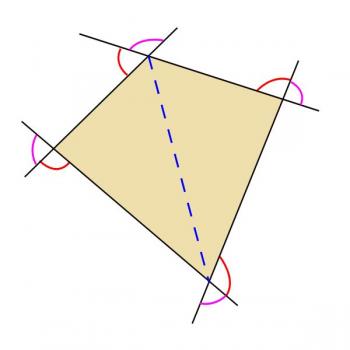
Now, my diagram is not just a quadrilateral - I've added some extra lines into it.
- The blue dashed line is a diagonal of the quadrilateral
- The sides of the quadrilateral have been extended to form exterior angles
- The purple arcs indicate angles which are opposite (vertical) to the interior angles of the quadrilateral
- The red arcs indicate the angles we're interested in.
Note that when we talk about the exterior angles of a quadrilateral, we're not talking about all the angles formed by the sides that lie outside the quadrilateral. We're not including the purple angles, and we're also not including the angles opposite the red ones. The exterior angles are all the angles "facing the same way" around the quadrilateral. That's not a very precise way of describing them, but hopefully you can see from my picture what I mean by that.
Okay, so how do we prove this? I'll give you two methods, and you can decide which one you like best. Ready?
Proof #1
- A quadrilateral can be divided into two triangles by a diagonal
- Each triangle has 180 degrees
- 180 x 2 = 360, so there are 360 degrees in the interior of a quadrilateral.
- Call these four angles a, b, c, and d. Then a + b + c + d = 360
- Each angle is supplementary to an exterior angle.
- Thus, the exterior angle measures are 180 - a, 180 - b, 180 - c, and 180 - d
- Adding these together gives (180 - a) + (180 - b) + (180 - c) + (180 - d) = 720 - (a + b + c + d)
- Since a + b + c + d = 360, this is equal to 720 - 360, which equals 360 degrees.
Proof #2
(Proof #2 starts out with some of the same steps as Proof #1)
- A quadrilateral can be divided into two triangles by a diagonal
- Each triangle has 180 degrees
- 180 x 2 = 360, so there are 360 degrees in the interior of a quadrilateral.
- Call these four angles a, b, c, and d. Then a + b + c + d = 360
- The intersecting lines at the four vertices form angles adding to 360 degrees
- Since there are four such sets of angles, their measures add to 360 x 4 = 1440 degrees.
- The purple angles from vertical pairs with the interior angles, so their measures are a, b, c, and d
- Thus, the sum of the red angles and their vertical counterparts is 1440 - (a + b + c + d) - (a + b + c + d) = 720 degrees
- Since vertical angles are congruent, we divide this sum in half to obtain the sum of the red angles: 720 / 2 = 360 degrees.
Incidentally, this proof can be extended to show that this is true not just for quadrilaterals, but for any polygon; the sum of the exterior angles is 360 degrees, regardless of the number of sides. Thanks for asking, Chanchal!
"If the two triangles shown are similar, find the value of d/c. I know the answer is 5/6, but I don't know how to get it." ~Kimberly
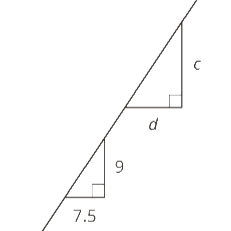
Good morning Kimberly. As we look at this question, I'd like to point out that it does violate one of our standard rules of geometry - which is that we never assume the diagrams are drawn to scale. The problem writer clearly intends for you to assume that the lines which appear to be horizontal really are horizontal, and the ones that appear to be vertical really are vertical. If you make that assumption, then you can conclude that the side of length 7.5 corresponds to the side of length d, and the side of length 9 corresponds to the side of length c. So we'll go with that assumption.
Since the triangles are similar, and we "know" which sides are corresponding, we can set up a ratio:
7.5/d = 9/c.
This does not give us what we want (d/c). However, we can rearrange that with just a couple steps to obtain the desired result. First multiply both sides by d, to get it in the numerator:
d(7.5/d) = d(9/c)
7.5 = 9d/c
Now divide both sides by 9:
7.5/9 = d/c
This is the ratio you want, except that it's not in simplest form. Multiply numerator and denominator by 2 in order to get rid of the decimal:
7.5/9 = 15/18 = 5/6.
And there's your answer. But I'm not quite done - I'd like to point out something that might be valuable to you. This problem shows us something very interesting that I often make use of when doing similar triangle problems.
We started with a ratio of corresponding sides, and when we were done, we ended with a very different ratio - the ratio of sides within a triangle.
Your standard rule is: The ratios of corresponding sides in two similar triangles are equal.
Our alternate version (which you can call the Kimberly Rule, if you want) is: The ratio of any two sides in a triangle is equal to the ratio of the corresponding sides in a second, similar triangle.
In other words, you could have started out with d/c = 7.5/9 instead of starting out with 7.5/d = 9/c.
I had a student ask today why Cramer's Rule works. That's the sort of question I love, but we didn't have time in class to work through it, so I thought I'd post the exploration of the question here. We'll consider the case of a system of two equations in two unknowns.
Cramer's Rule says that if you have a system written as follows:
ax + cy = e
bx + dy = f
Then we can find the values of x and y by evaluating the following determinants.
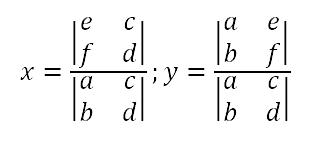
In case you're not familiar with determinants, we find the value of a 2 x 2 determinant by multiplying the numbers along the primary diagonal (top-left to bottom-right) and then subtracting the product of the other diagonal. Thus, this could be rewritten as follows:

So that's the form we're going to consider. Ideally, we'd like to show that given the system we started with, the solutions can be written in the form directly above.
If you were solving a system of equations with numeric coefficients, you might find the least common multiple of the coefficients of x, and then figure out what you need to multiply each equation by in order to get those coefficients to cancel. Unfortunately, we don't have numeric coefficients, but we can still do this process. What is the LCM of a and b? Why, it's the product of a and b! So we'll multiply the first equation by b, and the second equation by -a:
bax + bcy = be -bax - ady = -af
Adding these two equations gives us
bcy - ady = be - af
y(bc - ad) = be - af (factor out y)
y = (be - af)/(bc - ad) (divide both sides by (bc + ad)
Now, that doesn't exacly match the result we expected, but if we multiply the top and the bottom by -1, we get:
y = (af - be)/(ad - bc)
That's only half of the problem, of course; we've shown that the "y" formula works; now we just need to show that the "x" formula works.
And you know what? We'd show it exactly the same way, except we'd start by eliminating y instead of x. I'll leave that to you to work out on your own. And, of course, once you've finished that, you can develop your own proof for systems of three equations in three unknowns!
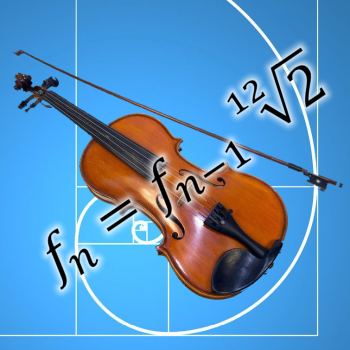
"I keep hearing about people who are good at math and music. But that seems so strange -- music is so artistic and flowery, while math is so technical and straightforward. How could either have anything in common with the other?" ~ Laura from Maine
Hi Laura, thanks for thre great question. I wish I could give you a solid scientific answer to this question, but the inner workings of the brain definitely are not in my field of study. Instead, I can give you some observations about both math and music, based on my own experiences as a mathematician and a musician.
First, I can confirm that what you said is typical in my experience - it is very common for people who are good at music to also be good at math (and vice-versa). Obviously, that's not a 100% rule (probably not even close!) but it is common enough that my high school math teacher used to refer to his best students as his "M & M students." Not because they liked chocolate in a candy shell, but because they excelled in both Math & Music.
So what's the connection? I'm going to suggest three connections: patterns, precision, and creativity.
Patterns in Music
Music is filled with patterns. That can be seen in the simplest of ways: a couple days ago I sat down with my five-year-old son and taught him a little bit about the piano. I showed him how to find the note C by looking for patterns. There are sets of three black keys, and there are sets of two black keys. C is any white key that comes right before a set of two black keys. From there, he could find any C on the keyboard. I showed him that the note names go from A to G, and then start over at A. From there, he could start at the low end of the keyboard and name every single white key on the piano. Patterns.
Eventually he will discover that there are certain intervals (major thirds, minor thirds, etc) that sound really nice together, and others that don't sound quite as nice. He'll discover that those intervals can be shifted up and down the keyboard by octaves, and then he'll discover that they can be shifted by other amounts, and the sound is just as nice.
Musical compositions are also filled wtih patterns. Just listen to Vivaldi's Four Seasons, and you'll hear the same "figure" repeated throughout a movement. Starting on one note, and then on another note, then with some variations to the pattern, but always with a pattern that your ear catches and hangs on to. Some of the most memorable classical compositions are the ones that have memorable patterns that appear over and over (think of "dum-dum-dum-DUM" in Beethoven's fifth symphony, or the themes of Rossini's "The Barber of Seville" and "William Tell Overture" - and if you're not familiar with those two compositions, think of Bugs Bunny as a barber, or the Lone Ranger).
Patterns crop up in more modern music as well - the pattern of verse-chorus-verse-chorus-bridge-chorus is one that gets repeated over and over again in popular music. Your brain processes those patterns even if you're not consciously aware of them.
As an added bonus: most of the patterns we notice in music have a mathematical reason why they exist. For example, an octave is an interval that sounds good because the frequencies of the notes are in a ratio of 1:2.
Patterns in Math
I'm not sure I even need to say that math is filled with patterns. It seems intuitively obvious. But let's consider just a couple things. First, I remember how fascinated I was when I first discovered the nine-times-table:
9 x 2 = 18
9 x 3 = 27
9 x 4 = 36
9 x 5 = 45...
...and so on. As the tens place increases by one, the ones place decreases by one, and in each case, the sum of the digits is 9. What a fascinating pattern.
Fibonacci was famous for discovering patterns, and exploring how they related to the natural world around us - for more on Fibonacci, you might want to consider this book, reviewed here by Book Scrounger: Blockhead: The Life of Fibonacci.
A couple days ago my son went for his yearly checkup, and his doctor commented that math learning at his age is all about finding patterns.
People who like looking for patterns will naturally be drawn to either math or music, or both.
Precision in Music
If you've ever taken music lessons, you understand this one. I remember, as a violin student, being expected to be very precise about a lot of things: how I hold the bow, how I hold the violin, where I put my fingers, how I draw the bow across the strings. And then I'd do scales over and over again, with my teacher telling me, "That C-sharp isn't sharp enough." or "Your bow is way down on the fingerboard." Getting good at playing a musical instrument requires a fairly stubborn and determined mindset to get it right. For a violin student, "getting it right" is sometimes a matter of a miniscule fraction of an inch one way or the other.
So when you said that "math is technical," my response to that is: so is music! Students who can't master the technical aspects will not excel.
Precision in Math
The same stubborn, determined mindset that makes someone decide they're going to practice a D-major scale until they get it right is necessary for a good math student as well. In elementary school it's memorizing those math facts. Then it turns into more and more complicated processes (arithmetic algorithms, arithmetic operations on fractions), and eventually the student is faced with complex algebraic and even calculus problems. And good math students practice these over and over again (it's why those cruel and nasty math teachers assign homework; doing 20 math problems is like practicing your D-major scale over and over and over again). You don't get that kind of precision any other way.
People who have the determination to keep practicing things are more likely to excel in math or music, or both.
Creativity in Music
Eventually, every violin student who sticks with it long enough gets to the point where their teacher says, "Okay, it's time to learn about vibrato." What is vibrato? Vibrato is, according to one dictionary: "a rapid, slight variation in pitch in singing or playing some musical instruments, producing a stronger or richer tone." In a sense, vibrato is a breaking of the rules, because you've been trying desperately to play in tune, and now your teacher is giving you permission to play out of tune. In fact, your teacher is demanding that you play out of tune. In my mind, it was at that moment that I moved from parroting to interpretation. You are no longer at the mercy of the musical composition; the notes on the page become a vehicle for your own personal expression. And vibrato is just one thing - whatever musical instrument you play, as you advance, you will discover more and more that there are ways to express yourself through creative use of the technical skills you've acquired. You've become creative.
And, do I need to mention? Writing musical compositions is a wonderful task in creativity!
Creativity in Math
Really? Math is "creative"? Sure it is! Math is problem solving! Math is curiosity, and exploring beyond what is known. When I graduated from high school, on Class Night, my math teacher presented me with a our school's highest math award, and at the same time presented me with a notebook which contained every math problem I'd solved during my independent study math course that year. What's the big deal about that (you might ask)? The big deal is that every one of the problems I worked on that year was a problem I made up myself, or decided to challenge myself with. Whether it was proving the quadratic formula, deriving a formula for the inverse of an N x N matrix, developing my own theorems, or just posing mathematical questions to myself and trying to solve them, I spent the entire year being creative. And that creativity is what makes a mathematician. Being a good mathematician doesn't mean being able to multiply 324 x 16.9; that's just the precision practice (like learning a musical scale); being a good mathematician means being able to take those skills you've practiced, and put them to use in new ways to solve problems you haven't solved yet.
When I have students who want to take my math classes as "honors level" classes, I expect problem solving from them; I expect them to take the things they've learned and put them to use in brand new ways that they've never thought of before. I expect them to combine two mathematical ideas that they've never used together before, and use them to develop a solution to a problem they didn't think they could solve. I expect them to get creative.
People who are willing to use the tedium of repeated practice to explore new ideas and new ways of doing things will excel at either math, or music, or both.
"There is geometry in the humming of the strings, there is music in the spacing of the spheres." ~ Pythagoras
"I hate converting degrees to radians and the other way. Degrees seem simpler why can't we just stick to that?"
Good question! Degrees have been around for a long time. There are varying theories about where the unit originated. Some suggest that 360 comes directly from the Babylonians' sexagesimal (base 60) system; 360 = 6 x 60.
Others suggest that 360 was chosen because it is (approximately) the number of days in a year. Thus, a degree is roughly the angle traversed by the earth in a single day.
One thing that is certainly true: in the days before calculators, having units based around highly composite number would have been convenient for division purposes. 360 is highly composite, having 24 factors. Look at it this way. If you wanted to divide a circle in half, thirds, fourths, fifths, sixth, eighths, tenths, twelfths, fifteenths, sixteenths (and many others) you could do so without having any decimals to deal with.
That's great, although having calculators makes that less important to mathematicians than it once was.
So that's where degrees came from. What about radians?
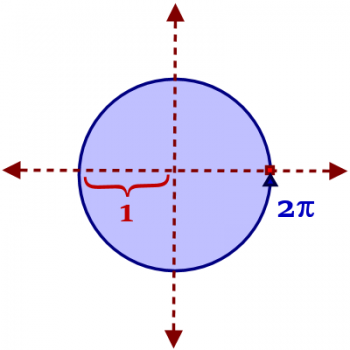
Radians come directly from a unit circle. When we talk about the unit circle, we're talking about a circle with radius 1, centered at the origin of the cartesian plane. If you look at the picture, you can see that the radius of the circle has been marked as 1 unit. Now look at the blue line, starting with the red beginning, and going all the way around the circle to the blue arrow. How long is that curved segment?
The answer to that question comes from the formula C = πd - the circumference is pi times the diameter. What is the diameter? It's twice the radius, or 2 x 1 = 2. Thus, the circumference is 2π. With that in mind, a rotation around the circle could be thought of as an arc-length around a unit circle.
Okay, so that's where radians come from - but it doesn't answer the question of why we use them. It does seem like 30º is easier to deal with than π/6, and 270º is easier to deal with than 3π/2. So why deal with radians at all?
Because, as you move through more advanced topics in mathematics, you'll discover that there are certain relationships that only work if you're using radians instead of degrees. Consider the infinite summation below:

This beauty only works if x is in radians; if it's in degrees, it does not work!
But pretty formulas aren't the only reason radians work better. Especially if you're dealing with rotational motion (a car's tires, for example), writing things in radians keeps it simple. Consider the following examples:
#1: A car's tires have a radius of 12 inches. Its rotational speed is 30 degrees per second. How far does the car go in 1 second?
#2: A car's tires have a radius of 12 inches. Its rotational speed is 0.5326 radians per second. How far does the car go in 1 second?
#1 Solution: To find the distance the car has traveled, we divide 30 by 360 to find out what fraction of the circle we've rotated. Then we multiply that fraction by pi and the diameter of the circle to get the distance traveled: 12 x 2 x 30 x π / 360 = 6.3912 inches.
Now, before we look at problem #2, It's important to notice that in your calculations you've multiplied by 2π, and divided by 360. That's 2π/360, which is the same as π/180. That should look familiar to you; it's the conversion factor to swap from degrees to radians. In other words, even though you didn't realize you were doing it, you converted degress to radians in order to solve the problem! Now let's look at the solution to the second problem (which, by the way, is identical to the first, just using different units).
#2 Solution: To find the distance traveled, multiply the radius by the rotation in radians: 12 x 0.5326 = 6.3912 inches.
Wasn't that solution much simpler? You didn't have to do any conversion factors; you just multiplied the radius times the angle! That's pretty sweet!
So, yes, it's a nuisance to have two different units (just be glad you don't have to throw gradians into the mix!), but in the long run, your mathematical and scientific life will be simplified by making the π/180 switch to radians!


